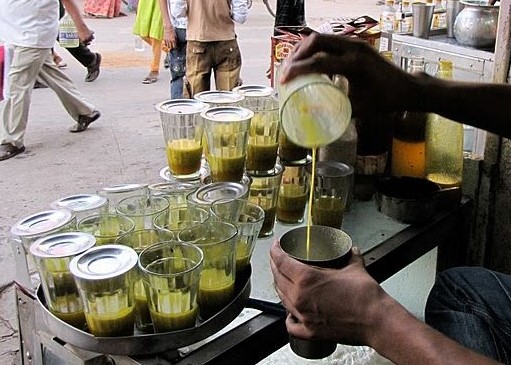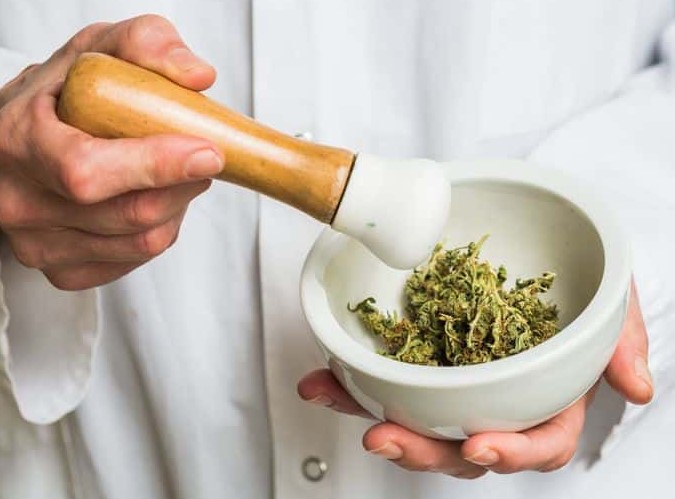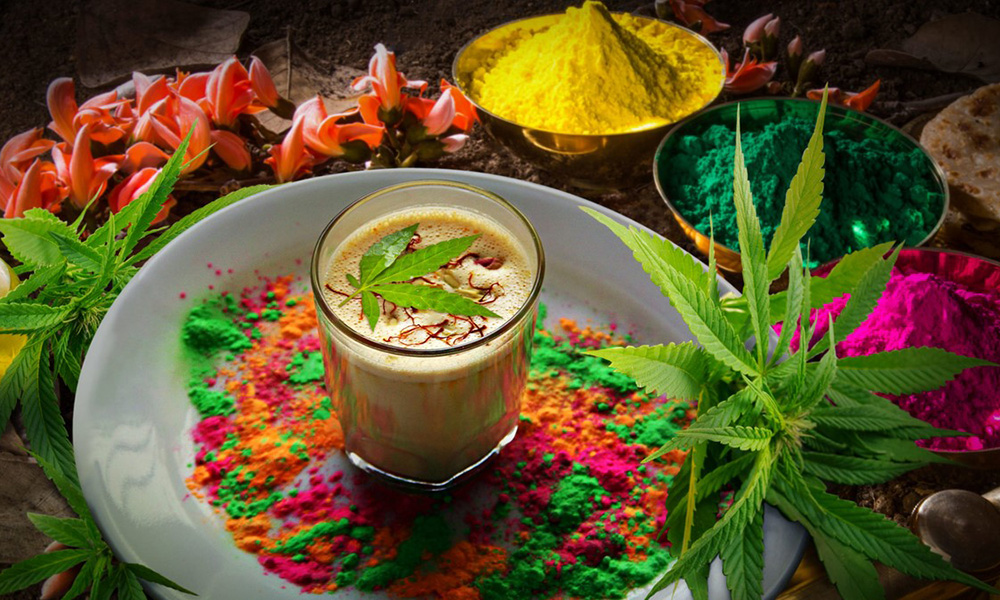Non classé
What is Bhang?
For a simple Bhang Thandai recipe, follow these steps. To begin, put two cups of water on the stovetop and bring to a boil. Add chopped cannabis leaves and flowers to boiling water and remove from the heat. Cover it and wait ten minutes before straining it. Place three cups of milk on the stovetop before warming it up. Combine the cannabis with a few tea spoons of warm milk in a blender or food processor and blend until smooth. Continue adding more milk until you’ve used half a cup. Remove the plant material and set the liquid aside. Combine the water, milk, spices, ground almonds, and rose water in a mixing bowl. Sugar or honey may be added to taste before chilling and stirring thoroughly before serving.
Bhang, or “drinkables,” is one of the most ancient and long-standing types of marijuana edibles in the world. It is a traditional and time-honored practice in Northern India for ingesting the plant.
Let’s look at exactly what bhang is and how to make your own refreshing cannabis-based drink at home.
What is Bhang?

Bhang is a concoction manufactured from the leaves and flowers of the female marijuana plant, which is technically referred to as bhang. The term, though, has now become associated with a beverage prepared using the paste.
The process of making bhang is known as “Hemp Paste Making” and entails soaking marijuana leaves and flowers in water before grinding them into a paste. The paste is traditionally formed into balls called bhang goli that are smooth, glossy, and green to dark brown in color.
The drink known as ‘bhang thandai,’ which is made from bhang, milk, ground nuts, and a variety of spices, is one of the most popular ways to use bhang. It also includes milk and ground nuts. Bhang thandai is typically consumed during religious holidays such as Holi, and bhang plays an important part in Hindu culture due to its ties with Shiva, the god of destruction. Although this may appear frightening, Hinduism does not consider devastation a negative characteristic because it allows for new life to emerge.
Shiva is said to have descended from the Hindu Kush mountain range, bringing bhang with him as a present for humanity. The god himself is reported to use bhang on a daily basis to increase his abilities, and he is also known as the “Lord of Bhang.” The relationship between Shiva and marijuana is so strong that he has his own cannabis souche named after him.
In India, bhang is a widely accepted and socially acceptable habit. It is so widespread that when the British colonized the country in the 1800s, they determined that prohibiting its use would result in too much civil unrest. As a consequence, they permitted its usage to continue, and it may still be purchased at authorized retailers today, especially in Northern India’s northern regions.
How does bhang work?
The leaves of bhang are used to make a drink that has been enjoyed in India for thousands of years. Bhang is well-known for its psychoactive properties, which means it can alter how your brain and nervous system function.
Cannabinoids, the primary active chemical components in the Cannabis sativa plant, are responsible for these effects. There are many different varieties of cannabinoids found in bhang, however the two most thoroughly researched ones are: (2Trusted Source)
- Tetrahydrocannabinol (THC). The psychoactive component in cannabis that causes the “high” felt after eating bhang-containing meals and beverages.
- Cannabidiol (CBD). Cannabis indica contains a non-psychoactive cannabinoid thought to be the primary component responsible for bhang’s health benefits.
CBD and THC both have a chemical structure that is comparable to those made by your body — known as endocannabinoids.
Endocannabinoids, which are cannabinoids that have been modified by the body, bind to cannabinoid receptors in your brain. They play a role in learning, memory, decision making, immunity, and motor function.
THC and CBD have a similar structure, therefore they may bind to your body’s cannabinoid receptors as well. This influences how your brain transmits messages between cells via the action of THC and CBD on these receptors.
Smoking or vaping dried parts of the cannabis plant causes blood cannabinoid levels to peak within 15–30 minutes.
Cannabinoids given through a food or beverage are absorbed into the body considerably more slowly, peaking around 2–3 hours later.
Possible risks
Although bhang may provide certain advantages, it also has associated health dangers.
Bhang is most recognized for giving a sense of euphoria, although it can also cause anxiety, dread, or sadness in some individuals. It may also impair short-term memory, coordination, and judgment while enhancing paranoia or psychosis when taken in large doses.
Children and teenagers should avoid bhang and other cannabis products unless they are being used as a medical treatment. Children who use bhang on a daily basis may have altered brain growth, increased school dropout rates, and decreased life satisfaction.
Cannabis items may also raise your risk of various diseases, such as depression and schizophrenia, especially in those who are at risk of developing them. Furthermore, smoking it while pregnant or nursing can raise the danger of premature livraison, low birth weight, and poor infant brain development. As a result, experts strongly advise against usage during these times.
Finally, eating or drinking bhang as a food or beverage slows down its absorption, making it more difficult to estimate and change your intake. This can lead to overconsumption, which causes erratic heartbeats, low blood pressure, and confusion.
Benefits of Bhang
Bhang has been used in Ayurvedic medicine for hundreds of years. It is one of the five sacred plants mentioned in the Atharva Veda (an ancient Hindu text compiled around 2000–1400BC), one of the six Vedas (a collection of ancient Indian texts). According to legend, bhang helps with the following ailments:
- Digestive issues
- Headaches and migraines
- Anxiety
- Pain and rheumatism
- Fever
- Sunstroke
- Dysentery
- Malaria
We now know, of course, that the cannabinoids, terpenes, and flavonoids produced by cannabis plants have a long list of health advantages. It appears that the Hindus were a little ahead of their time in recognizing the plant’s numerous benefits.
However, the effects of bhang are not restricted to medicine. Sadhus (Hindu holy men) utilize the preparation to assist them in their meditation and yoga exercises, and it is said that ancient warriors would use it to relax before a fight. According to folklore, bhang provided an anxious soldier with the confidence to slide beneath an armed elephant and kill it, allowing his army to triumph.
Cannabis is also regarded as a powerful aphrodisiac, and it’s frequently used by couples on their wedding night. Perhaps it’s no coincidence that the Kama Sutra, the most renowned sexual instruction book ever produced, was released in a nation where cannabis plays such an important role in people’s lives!
Bhang Thandai Recipe
If you enjoy bhang and want to make your own refreshing marijuana beverage at home, you’ll be relieved to learn that the procedure is not difficult. There are several methods for preparing your bhang thandai, and a quick search on Google will provide you with a plethora of different recipes for making the drink.
In India, you may purchase bhang and goli at a bhang store and combine the ingredients in a food processor. However, in the Western world, we must be more inventive.
To make bhang in the most traditional manner, you’ll need a mortar and pestle, as well as certain other equipment. Making your own infused drink with just a little effort is very simple once you have this.
Here’s a fast bhang thandai recipe for you to try at home.
Bhang Thandai Recipe (serves two)
For our bhang thandai recipe, you will need the following equipment and ingredients:
Equipment
- Large saucepan with lid
- Mortar and pestle
- Fine mesh strainer or muslin cloth

Ingredients
- ½ – 1 ounce of fresh cannabis leaves and flowers Ace of Spades
- 2 cups of water
- 3 cups full-fat milk
- ½ cup sugar or honey
- 2 tbsp ground almonds
- ¼ tsp ground ginger
- ¼ tsp ground fennel seeds
- ¼ tsp garam masala
- ¼ tsp ground black pepper
- ½ tsp cardamom
- ½ – 1 tsp rosewater
- Chopped pistachios to garnish (optional)
Method
- Place the water in a pan on the stovetop and bring to the boil.
- While you wait, finely chop your cannabis leaves and flowers.
- Add the cannabis to boiling water and remove from heat.
- Cover and leave to soak for 10 minutes.
- Strain to remove the plant material from the water and set liquid aside.
- Place the milk in a pan and warm on the stovetop.
- Place the cannabis in a mortar and pestle with a couple of teaspoons of the warm milk and grind to a paste.
- Continue adding more milk a couple of teaspoons at a time and grinding until you have used around half a cup.
- Strain the plant material from the milk and set liquid aside.
- Squeeze the paste to ensure that you get out all of that marijuana goodness.
- Add together the water and milk that were used to extract the cannabinoids and mix well.
- Add the remaining milk, spices, ground almonds, and rosewater to taste along with sugar or honey.
- Chill and stir well before serving.
Note
Fresh cannabis leaves and flowers are required in this recipe. It’s a fantastic way to use up any spare fan leaves or trim from your garden. It’s possible to make the dish with dried and cured marijuana flower, but doing so will be more difficult. Dried bud may boost the potency of your bhang thandai, therefore you should adjust the quantity used accordingly.
Getting the Most Bhang for Your Buck
Because cannabinoids such as THC and CBD are fat-soluble, you must combine them with a high fat content to maximize their absorption. As a result, full-fat cow’s or goat’s milk is the most effective way to make your bhang thandai.
If you’re vegan, you might use plant-based milk to make your bhang thandai, but the flavor and potency may be reduced. Choose milk with a higher fat content than average, such as coconut milk, for optimum results. You may also improve the richness of your bhang by adding a spoonful of yogurt, ghee, melted butter, or coconut oil to the finished mix.
Final Thoughts
Bhang is a centuries-old form of cannabis consumption prevalent among the Hindu people of Northern India. It is used to help with relaxation and meditation, as well as having a variety of health advantages.
Bhang thandai is a beverage prepared from bhang that is typically consumed during religious feasts. Making your own bhang thandai at home with only a few basic tools is easy, and it’s delicious and refreshing as well.
If you’ve ever experimented with edibles, you’ll be aware that consuming cannabis this way has a strong impact and can take up to two hours to kick in. As a result, it’s best to exercise some caution when ingesting bhang and start with a little dose first. You may gradually increase the amount of bhang until you understand how it will affect you.


